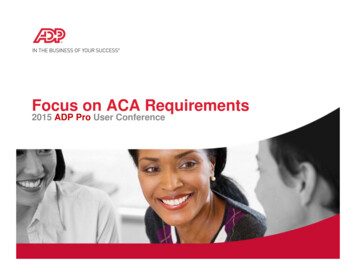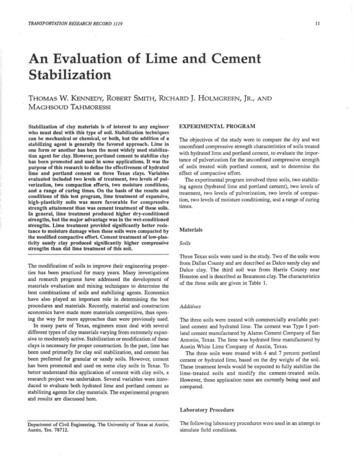
Transcription
Attachment ThreeConsumer Liaison Committee8/12/22Section 1557 of the ACAThe New Proposed Federal Rule, What StateRegulators Need to Know and How They Can Act
Attachment ThreeConsumer Liaison Committee8/12/22Roadmap of Presentation Background WhatHas Been Restored History, Scope or Rule Impactof Rule Opportunitiesfor Responses
Attachment ThreeConsumer Liaison Committee8/12/22Background201620202022ACANarrow InterpretationProposed RuleEstablished healthpolicy for providersreceiving federalfunding.Previousadministration offeredsignificant changesthat narrowed the1557 RuleRestores ACA originalprotections. Looks totake some provisionsfurther.
Attachment ThreeConsumer Liaison Committee8/12/22IMPACT ON CARERace/EthnicityMental Health
Attachment ThreeConsumer Liaison Committee8/12/22Restoration of the Full Scope of SexNondiscrimination Protections 2016 rule: Gender identity, sex stereotypes, and pregnancy status included underthe definition of sex Specific examples of gender identity nondiscrimination in coverage andcare Followed previous action by 20 state regulators to prohibitdiscrimination against transgender people, particularly in benefit design 2020 rule: Eliminated gender identity, sex stereotyping, and pregnancynondiscrimination protections Also eliminated sexual orientation and gender identity (SOGI) protectionsfrom various CMS rules
Attachment ThreeConsumer Liaison Committee8/12/22Restoration of the Full Scope of SexNondiscrimination Protections 2022 rule: Based on the 2020 Supreme Court decision in Bostock v. Clayton County, re-establishes gender identity nondiscrimination protectionsunder the basis of sex and adds sexual orientationRe-establishes protections on the basis of sex stereotypes andpregnancy statusClarifies that sex-based distinctions are allowed, but only if they causede minimis harm to beneficiaries or patientsClarifies that religious/conscience exemptions will be considered on acase-by-case basis by OCR under existing federal lawsDoes not require providers to perform services outside of their scope ofpractice or area of specialtyRe-establishes CMS regulations that were eliminated by the 2020 rule
Attachment ThreeConsumer Liaison Committee8/12/22Data Collection and Clinical Algorithms Several Executive Orders require the collection, analysis, and reporting ofdemographic data for various purposes, including civil rights enforcement OCR proposes to rely on existing authorities to promote the recurringcollection of data on leading civil rights indicators related to access andbarriers to opportunities and services OCR seeks comments on whether a new requirement to collect data wouldhave utility for regulators and covered entities Several other provisions also relate to data through research and clinicalalgorithms Covered entities may not discriminate in federally supported research (in,e.g., study enrollment) Clinical decisionmaking algorithms cannot incorporate bias that results inreduced access to health care or coverage benefits or services
Attachment ThreeConsumer Liaison Committee8/12/22Benefit Design: Network Adequacy Network adequacy is a major consideration in advancing health equityand ensuring high quality of coverage (Workstream 5 presentation inJune 2022) Network inadequacy can cause: Alienation from care and poor health outcomes, especially for chronicconditions Patient complaints and lawsuits, low quality scores OCR does not propose to establish a single network adequacy standardbut notes that narrow networks may pose discrimination concerns OCR seeks comments on how Section 1557 might apply to providernetwork design, particularly for people with disabilities and others withspecific health conditions, in addition to the general requirements relatedto race, color, national origin, age, and sex
Attachment ThreeConsumer Liaison Committee8/12/22Nondis
Restoration of the Full Scope of Sex Nondiscrimination Protections 2022 rule: Based on the 2020 Supreme Court decision in Bostock v.Clayton County, re-establishes gender identity nondiscrimination protections under the basis of sex and adds sexual orientation Re-establishes protections on the basis of sex stereotypes and pregnancy status











